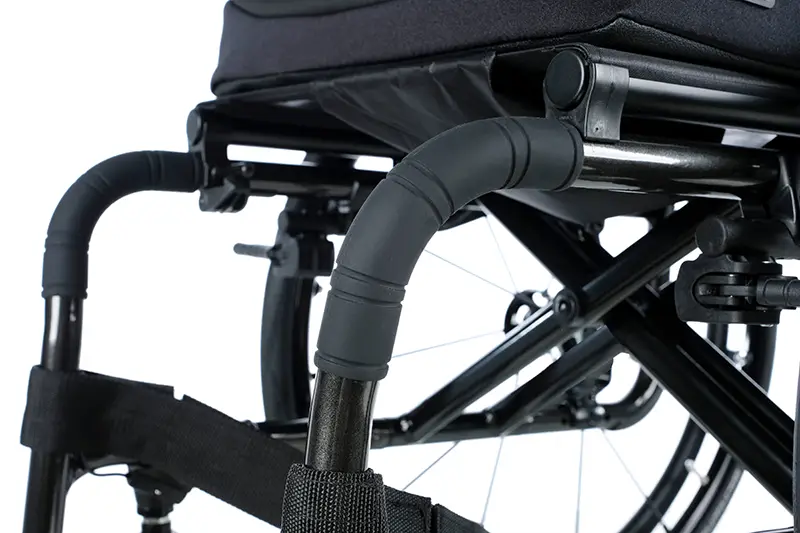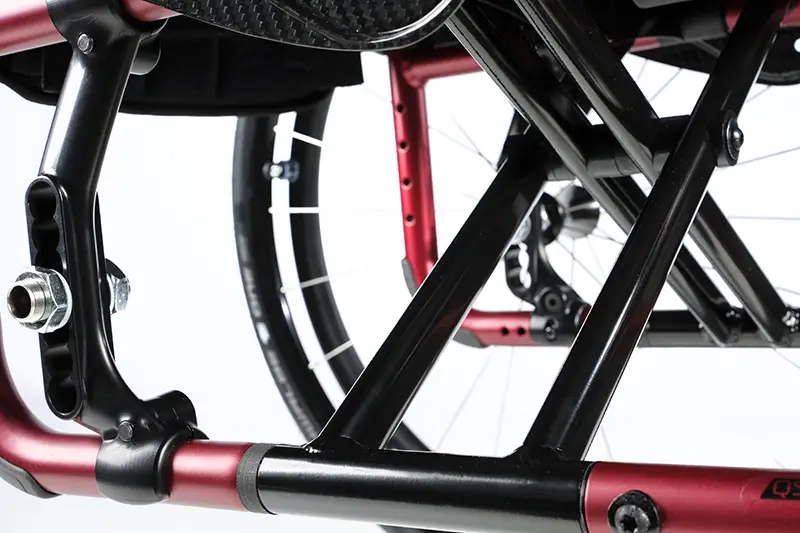Back in 2005, the Consortium for Spinal Cord Medicine with funding and support provided by Paralyzed Veterans of America recommended that riders be provided with a high strength, fully customizable wheelchair made of the lightest possible material as part of the Upper Limb Preservation Guide.3 Similarly, the RESNA position states an ultra lightweight wheelchair (ULWC) should be designed using the most current technology to ensure the wheelchair is fully customizable and is constructed of materials that minimize weight.5
As discussed previously, weight is a nuanced topic among both active wheelchair riders and experienced wheelchair prescribers. Riders will often identify weight as a primary consideration when choosing a wheelchair and communicate a desire to pursue a wheelchair made of a particular material in an effort to reduce weight, improve propulsion efficiency, and increase the ease with which they can independently lift the unoccupied wheelchair. However, the weight of a wheelchair is not necessarily dependent upon the material selected. So, of all the products and materials available, the question is how can the quality of an ULWC be measured?
Most often, ULWC quality is defined by individual riders based upon the impact on their participation outcomes. Therefore, rider-driven innovations like ergonomic wheel locks, hinged anti-tips, and soft touch points to improve handling and protect the frame can impact the perception of quality. For instance, ergonomic wheel locks require less force to safely lock and unlock, improving the ease with which the rider is able to engage the lock and providing independence for riders with functional strength limitations. Similarly, hinged anti-tips were designed to flip up when contacting a curbstone or step, limiting disruption to forward movement when wheeling over uneven terrain. Finally, soft touch points were placed in the areas most commonly used by riders to grip and lift the chair during transport, improving handling and protecting the frame. Ultimately, what may be perceived by some as a simple convenience may in fact be what allows a rider to be truly independent and confident in managing their own wheelchair.

Still, it is important to consider the reliability, durability, and maintenance of a product.5 This requires a deeper understanding of materials science. When discussing materials, it is important to understand how the properties of a material determine its composition and structure. Ultimately, the properties of the specific material determine its application and how it is used within the manufacturing process.1,4 For instance, aluminum alloys are characterized by having low density and are divided into series (from 1000 to 9000) based on the major allowing elements. Initially, 6000 series aluminum alloys were incorporated into wheelchair design to provide strength and durability while offering good corrosion resistance and ease of welding. More recently, 7000 series aluminum was introduced, offering a higher strength-to-weight ratio as compared to the previous 6000 series products which allows manufacturers to use a thinner wall thickness to reduce weight.2
In addition to the materials themselves, structural design contributes to the quality of an ULWC. For example, several Sunrise Medical wheelchairs use ovalized tubing in the frame or the cross brace. As compared to round tubing, the oval tube shape increases rigidity, reduces flex within the frame, and allows for a lighter overall frame weight by reducing the tubing wall thickness. The QUICKIE QS5 X in particular has an ovalized cross brace with internal liners to reinforce high stress areas without adding unnecessary weight. For the rider, this translates to reduced frame flex and increased stability for a stiff, rigid-like feel.

Furthermore, the fabrication method impacts the quality of the final product. To manufacture the QUICKIE Nitrum, Sunrise Medical uses ShapeLoc technology to increase frame stability and torsional stiffness in high stress areas without adding weight. ShapeLoc is a technology that uses hydroforming, a specialized method of manufacturing that applies high pressure hydraulic fluid to press aluminum tubing set at room temperature into a die. Simultaneously, axial pressure is applied to the ends of the tube. The material then enters the forming zone, allowing the aluminum tube to attain a structurally rigid, ovalized form.6 Once shaping of the frame structure is complete, the 7000 series aluminum is then heat treated to preserve strength in the areas of welding. For the rider, this provides a more responsive and efficient ride quality and ensures greater durability over the lifetime of the frame.2
These features contribute to the chair's strength, rigidity, and responsiveness, resulting in an efficient transfer of energy from the rider to the wheels. Therefore, while clinicians strive to maximize the rider's independent function, reduce strain on the rider's body, and minimize the risk of overuse injuries, it is important to consider the implications of materials science and manufacturing. Without a solid structure, longevity and performance of a wheelchair may be compromised and impact the rider's independence.
References
- Definition of materials science. (2023). Merriam-Webster: America's Most Trusted Dictionary. https://www.merriam-webster.com/dictionary/materials%20science
- Lee, J., Bong, H.J., Kim, D., et al. Mechanical Properties and Formability of Heat-Treated 7000-Series High-Strength Aluminum Alloy: Experiments and Finite Element Modeling. Met. Mater. Int. 26, 682-694 (2020). https://doi.org/10.1007/s12540-019-00353-9
- Paralyzed Veterans of America Consortium for Spinal Cord Medicine (2005). Preservation of upper limb function following spinal cord injury: a clinical practice guideline for health-care professionals. The journal of spinal cord medicine, 28(5), 434-470. https://doi.org/10.1080/10790268.2005.11753844
- Patel, C., Kumar, N., McCullough, R.L., Venables, John D., Girifalco, Louis A., Marchant, Roger Eric and Kukich, Diane S. "materials science". Encyclopedia Britannica, 3 Sep. 2023, https://www.britannica.com/technology/materials-science
- Rehabilitation Engineering & Assistive Technology Society of North America. (2022). RESNA Position on the Application of Ultralight Manual Wheelchairs. Retrieved from https://www.resna.org
Sarah Leonard PT, DPT, ATP specializes in neuro rehab with experience in spinal cord injury and brain injury rehabilitation. As a PT, Sarah has trained under industry-leading professionals who fostered her love for complex rehabilitation technology. As an ATP, Sarah has experience working for a national complex rehabilitation technology supplier. Additionally, Sarah presently serves as the assistant coach for the United States Wheelchair Rugby Association Low Point Team and has been an active participant in adaptive sports and recreation throughout her career.